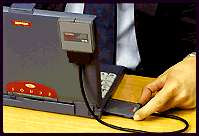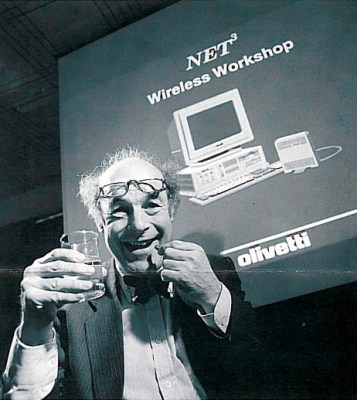If you sign up for a European hacker camp such as CCC Camp in Germany or SHA Camp in the Netherlands, you’ll see among the items recommended to take with you, a DECT handset. DECT, or Digital Enhanced Cordless Telecommunications, refers to the set of standards that lie behind the digital cordless telephones that are ubiquitous across Europe and some countries elsewhere in the world. These standards cover more than just the simple two-way telephone calls through a base station that most Europeans use them for though, they define a fully functional multi-cell 3G phone and data networking system. This means that an event like SHA Camp can run its own digital phone network without having to implement cell towers.

Reading the history of DECT, there is the interesting snippet that the first DECT product on the market in 1993 was not a telephone but a networking device, and incidentally the first wireless LAN product on the European market. Olivetti’s Net3 provided 512kB/s wireless networking to a base station with Ethernet or Token Ring interfaces for connection to a LAN. In its original form it was an internal card for a desktop PC coupled to a bulky external box containing radio circuitry and antenna, but its later incarnations included a PCMCIA card with a much smaller antenna box. The half-megabit speed seems tiny by today’s standards, but in the pre-multimedia world of 1993 would have been perfectly adequate for a Novell Netware fileserver and an HP Laserjet 4.

Mystery Technology
So DECT is an interesting technology that can do more than just a simple cordless phone, and its first product was unexpectedly somewhat groundbreaking. It then becomes even more interesting to find that Net3 has left very little evidence of itself to find that can be found on the Web, and learning more about it requires a little detective work.
The Wikipedia entry has the bare bones, but it speaks volumes about the obscure nature of the product that the encyclopedia’s only picture of it is a tiny thumbnail-sized promotional image of the PCMCIA variant in a chunky mid-1990s laptop. A further search reveals a 1993 British Olivetti staff newsletter (PDF) carrying another promotional image of the desktop Net3 device featuring the then-well-known TV personality and academic [Heinz Wolff] demonstrating the technology bizarrely by swallowing a DECT medical instrumentation transponder wrapped in a condom. Some press releases remain in the fossilized remnants of the 1990s internet, and a Net3 design team member’s LinkedIn page led us to the patent covering the system, but that’s pretty much it. We can’t even find a high enough resolution image of a Net3 card for our featured image slot.
Wireless Things Before Their Time
It’s obvious that Net3 and DECT networking as a high-end wireless LAN before a need for wireless LANs existed never made it, but what is perhaps more interesting is that it seems to have left no legacy for other more mundane applications. We are in the midst of an explosion of hype around the Internet of Things and it seems new short-range wireless networking technologies appear almost daily, yet the world seems to have overlooked this robust, low power, and mature wireless network with its own dedicated frequency allocation that many of us already have in our homes. It seems particularly surprising that among the many DECT base stations on sale at your local consumer electronics store there are none with an Internet connection, and there is no market for IoT devices that use DECT as their backhaul.
In the open-source community there has been some work on DECT. The OsmocomDECT project for example provides a DECT software stack, and deDECTed.org states an aim to “better understand DECT and its security and to create an Open Source implementation of the DECT standard”. But there seems to have been very little hardware work in our community on the standard, for example there are no DECT-specific projects on Hackaday.io.
Net3 then was a product before its time, a herald of what was to come, from that twilight period when the Web was definitely a thing but had yet to become the world’s universal information repository. Public wireless networking was still several years in the future, so there was no imperative for road warriors to equip themselves with a Net3 card or for computer manufacturers — not even Olivetti themselves! — to incorporate the technology. It thus didn’t take the world by storm, and unusually for such a ground-breaking computer product there remains little legacy for it beyond a rarely-used feature of the protocol Europeans use for their cordless phones.
Did you have a Net3 card? Do you still have one? Let us know in the comments.
















DECT is still popular in the US for cordless phones, as this Staples page shows:
https://www.staples.com/dect/directory_dect?fids=Department_3A_22Phones_22
Your OsmocomDect link is retro too – the stack seems to be way behind the current kernel version, and good luck finding a comm-on-air card :-(
I haven’t played with it in a while but I still have mine laying around. Made a video demo some time ago. https://www.youtube.com/watch?v=omS7OMLAnaA
You do need to be running an old kernel of course, I think I was using Backtrack 5 in that video. I have a custom distro dedicated just for this card since it hasn’t been updated in so long and I wouldn’t know the first thing about bringing it back up to date.
DECT is also ised for cordless phones in the UK and popular for baby monitors
Dialog Semiconductor has some DECT stuff targeting IoT applications (https://www.dialog-semiconductor.com/products/smartpulse) although there doesn’t seem to be much on the market even in Europe. The only thing I’ve seen other than phones and baby monitors is a version of the Eurotronic Comet thermostatic radiator valve, and it isn’t particularly clear what you’re supposed to connect it to!
Check here (Google translate May be required) https://avm.de/ratgeber/smart-home/
Ericsson was one of the pioneers.
netsource.com/ericsson_dect_equipment_111.html
This is part of the legacy, dect was more or less like a mobile system,
Including data transfer capacity.
en.m.wikipedia.org/wiki/Ericsson_Mobile_Communications
Siemens had a DECT-Set for a serial Link, the Gigaset M101 Data. I used it before Wifi and DSL to replace the long phone line through the flat (one Gigaset and modem next to phone, other Gigaset connected to computer).
Well, networking equipment manufacturer AVM uses it for Home automation. See https://avm.de/ratgeber/smart-home/heizkosten-reduzieren-mit-fritzbox-und-fritzdect-300/ as an example.
That is no surprise as they produce the line of FritzBox routers/modems which are quite popular in Germany and more often then not contain a DECT base station.
Worked for Olivetti during that time. I was lucky enough to have most of the latest technology/products on my desk or on that of my colleagues nearby. What I can say about the net3: I don’t remember it… The thing with Olivetti is that although they developed some very innovative and good products, marketing was not their strongest point and the information did not spread.
Some of the things I remember: – The not so portable M18P and M21 computers. – The Quaderno (1992) was a A5 footprint notebook that was effectively useable on batteries and not just a prototype but mass produced (it was XT compatible and weighted only 1kg). – They also made the first inkjet technology printers (HP purchased/licensed that thing from them). – Back in 1990 they had a multi-head harddisk storage on SCSI (what one would call a SAN today). – The Envision multimedia computers. – Any so much more.
I remember the Quaderno, and there was a time when everyone had an Olivetti inkjet.
AVM offers switchable power outlets using DECT for their famous Fritz!Box home routers: https://en.avm.de/products/fritzdect/fritzdect-200/
>512kB/s wireless networking
>The half-megabit
make up your mind
Darn, I’m sad I didn’t spot that one. (For others who didn’t spot it yet, 512KB/s is 4MB/s, not 0.5Mib/s.)
Easy error to make, these annotations are more cryptic than… Well, the Apple SEP now, among other things.
Case in point… 512KB/s is 4Mb/s, not 4MB/s. ;)
Actually, it’s slightly smaller than that, because
You know what, I give up. Have some XKCD. https://xkcd.com/394/
Yepp. Indeed, both numbers are wrong.
That is, if you agree on the same definition for bits (b, bit), bytes (B) and the binary (Ki, Mi, Gi, Ti, Pi, Ei) and decimal (k, M, G, T, P, E) unit prefixes that the industry and scientific community, especially the international standards bodies agree upon.
I guess it is a good thing that it is my freedom to interpret a different meaning to the words I read or hear, like using a compromise between 1000 and 1024 as a universal unit prefix (thanks for the XKCD link!).
But then again, I have to imagine a certain blond individual actually having the power to enact, by decree, an even different interpretation as a law or something..
The Orange-utan’s next soap box: Enacting the hard-drive manufacturer’s kilobyte as a function of US law.
Perhaps not 100% pedantically, technically, correct, but I tend to use:
mbit/s, kbit/s, bit/s
MB/s, KB/s, byte/s
I tend to be somewhat lax on the 2^10 vs 10^3 numbering, as the number i’m throwing around are usually sloppy estimates. I usually only elaborate when there’s a need to extinguish all possible ambiguity.
In the US one of the primary desirable features of DECT is that it’s on a frequency band that isn’t used for everything like 2.4ghz and doesn’t have the penetration problems of 5ghz. Admittedly cordless phones aren’t much of a loss these days but I’d still be kinda pissed if I had to dig up an old 27mhz system or something because IOT vendors decided the DECT band was the new hot place to stick their overcomplicated unsecured lighbulbs.
“The half-megabit speed seems tiny by today’s standards, but in the pre-multimedia world of 1993 would have been perfectly adequate for a Novell Netware fileserver and an HP Laserjet 4.”
I’m still rockin’ a LaserJet 4 plus, presumably manufactured in May 1994. Replaced laser diode module (it fried), and replaced all rollers (fuser still seems in good shape, perhaps it was replaced), belts, and few gears. Still churns out pages when asked. With 36MB RAM, it seems to keep up with pretty much any modern (consumer) 600dpi black-and-white laser printer i’ve seen.
How is this possible? Are they still making toner cartridges that fit into this thing?
It’s the curse of Italian engineering. We build stuff, we even market and sell stuff, but usually a foreigner has to come in a few years later to actually properly invent it… Also see Bell vs. Meucci.
Panasonic has few home automation products that runs on DECT. They call it Home Monitoring Network. I own a full set which acquired for 100$ including 4 cameras. Main intention was hacking it when I bought it but I find little to no information on the technology and their products. Main hub seems to be well protected for network hacks so only solution is to hack the DECT and directly communicate with all the sensors :).
However I dont recommend the panasonic system for anyone even if you find the full set for 100 or less (poor software quality). Unless we manage to hack it use it with something like Openhab.